#writing disability with Cy Cyborg
Explore tagged Tumblr posts
Text
Free Manual Wheelchair Reference Models

ID: A banner with grey 3D models of 5 kinds of manual wheelchairs in a line in front of the disability pride flag and text that reads "Manual Wheelchair References" /End ID
For disability pride month, I decided to release a pack of 3D manual wheelchair models.
The pack includes 5 wheelchairs:
2 Active urban-style chairs (one of which includes a smart drive)
1 off-road active chair
1 children's wheelchair
and 1 standard "hospital" wheelchair).
All the wheelchairs are based off either wheelchairs I or friends of mine have used
Downloadable here!
or on the Clip Studio Paint Asset Store (ID 2097442) (there's been an issue with the CSP version, but the models in the download folder can be imported into clip studio paint until I can fix it)
More info about the download contents below:
The first download link includes the original .Blend file with all 5 chairs, as well as individual .obj or .fbx files the chairs (All but 1 have an .obj file, as they're only meshes. The chair with the smart drive is rigged, which is why it has an .Fbx file instead so it will retain that information) as well as a "read me" file that explains in more depth what kind of disability/character/lifestyle each chair is made for (These are just what I had in mind when I designed them, they are usable by other characters who don't fit the suggestions for the most part!) I wanted to include the Read Me contents in the CSP Asset Store listing, but CS said it was too long lol.
Also, as the title says, these files are free to use! While it's not mandatory, I would appreciate credit if you use them (or even just a tag so I can see the cool art you make with them!!)
I actually made these ages ago, the original plan was to use them in a series of posts then release the pack, but I never got around to making the series and so they've just been sitting here. I took a day off from art fight attacks to clean them all up and get them ready to post. If you experience any issues, let me know and I'll try to fix it up.
I had a couple more that were supposed to be in the pack including a sports (basketball/Tennis) wheelchair and some different styles of wheelchair, but I think the files corrupted so once I fix (or remake) them, I'll probably make a second pack.
If you have any issues, please let me know!
#Writing Disability With Cy Cyborg#Disability in art#wheelchair#wheelchair user#disability#disabled#disability representation#mobility aids#drawing disability#drawing wheelchairs#art reference#art resources#Resources#manual wheelchair#art stuff#disabled artist#3d#3d model#blender#disability awareness#disabilities#disability in media
7K notes
·
View notes
Text
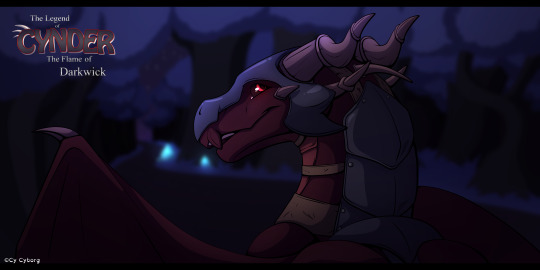
Chapter 5 of my fic is up on Ao3!
This chapter took me way too long to finish, so I'm thinking I might take a breather and skip next week's upload. We'll see how it goes lol.
As for the artwork for this chapter, it's nothing too out-there, but I decided to try some new stuff for the background and lighting/shading, and I think it looks quite nice. It's not something I'd use in all my art, but it's good for drawings like this and my comic that I want to be able to do quickly.
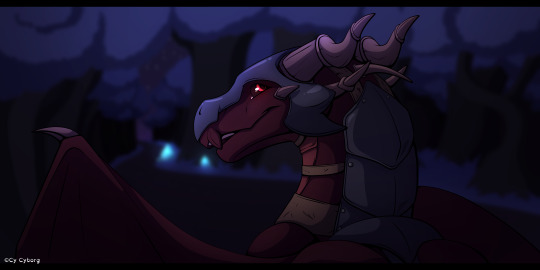
[ID 1: An image of Valori, a dark red dragoness with bright red eyes, wearing dark, metal armour, looking back at the viewer. In the background is a forrest of trees with blue leaves at nighttime. In the top left corner is a logo that reads "The Legend of Cynder, The Flame of Darkwick" /End ID 1] [ID 2: A copy of the first image, just with the logo removed. /End ID 2]
#Cy Cyborg Draws#disabled artist#queer artist#writing#writeblr#my art#digital art#Ao3#ao3 fanfic#fanfic#fanfiction#ao3fic#spyro oc#spyro the dragon#the legend of spyro#spyro fanart#spyro#legend of spyro#cynder the dragon#dragon#dragon art#armored dragon
27 notes
·
View notes
Text
Stop Using Slurs in Children Stories!
I bet that caught your attention. You might be thinking, what stories use the N-word, or the F-word, well...none that I found. However, there are two slur words that are often used in writing mainly in children's literature because I don’t think enough people know them to be slurs. Those words are cripple and savage.
Before I begin, I need to address a few things. First, I'll only use these words in full for educational purposes so nothing gets confusing. Secondly, I’m not hating on any of these authors. I genuinely think these people might not know cripple and savage are slurs. However, I still need examples of what I’m talking about to explain how common these words are used in writing as well as explaining why it’s a bad idea to use them, so I’m using these authors, not as targets but as examples based on the books I have.
Both of these words (cripple and savage) have a lot of history behind them, and while I strongly suggest, not using them, if for some reason, they have to be used, you need to hire a sensitivity reader who’s a part of the communities that has been affected by said words before you publish your story.
Cripple:
Before I begin, please understand I’ve consulted with a disabled person who’s well knowledgeable in this topic to help smooth out my points. I’m not apart of the physically disabled community. As I’ve been told there’s a big debate going on within the disabled community in regards to if mental disabled people are allowed to use the word cripple or not. This is beyond my understanding of the word, and the community so when I mention the word cripple, I’ll be referring it to the physical disabled community and not the mental one. Everything I’m about to say has already been said by the physically disabled community. I’m not adding anything new or talking over them. If you would like to know more about the language of disability, please read Cy-Cyborg’s article on the matter: https://writingwithcycyborg.blogspot.com/2024/02/LanguageOfDisability.html
Cripple is a world that’s defined one of three ways, to either describe someone who can’t function properly, to describe a situation that’s overwhelming, or to describe an object that isn’t working.
Example one: DragonFire: Sphere of Eternity (book 1)

“I mean, this morning, no offence, you were crippled.” (Describing a person.)
Example two: “The economy was crippled.” (Describing a situation)
Example three: DragonFire: Age of Legend (book 3) (describing an object)
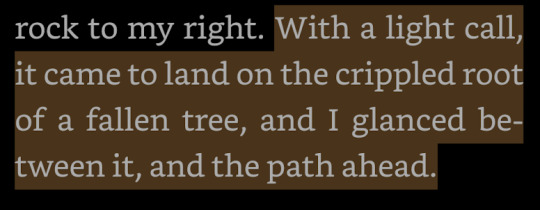
The word cripple, even when it was used in a medical sense has always been a word to punch down and insult the physically disabled community. It was used to attack them and point out their disabilities. It became a common replacement for the word injured because it has a more of a punch. Instead of calling someone “severely injured” use cripple instead, it’s shorter and a lot punchier of a word. Over time it became part of normal vocabulary to use it while describing something as severe, despite it still being used as an insult at the same time. Let’s look at an example of how it’s being used to describe an injury in Robert Vane's A Dragons Chains: Book one of the Remembered War

“I moved my three non-crippled legs…” In this example, the dragon has an injured leg. Why did the author use the word cripple instead of injured? I think it’s because of shock value. Is it cheap shock value? Yes, but shock value for the reader is still shock value. Tell me, what’s the difference would be if the author replaced the word cripple with injured? “I moved my three non-injured legs...” Does using the word cripple add to the sense of urgency? Add to the sense of how injured that character's leg is? Or was it merely just a place for shock value?
But how often is this word used? Let’s take a quick look at the DragonFire series. There are currently four books in this series at the time of writing, and the word crippled is used twelve times throughout four books. Knowing it’s a slur...that’s a lot.
Some of the examples in which it was used are in things such as DragonFire: Fallen Star (book 2) where it reads:
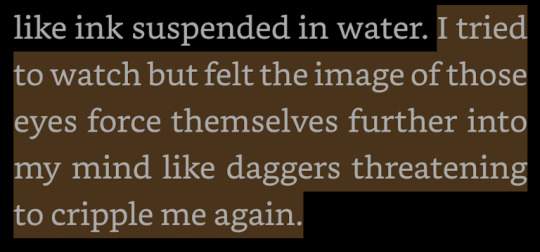
Or
“...he yelled, his scythed tail coiling round, only for the far less crippled dragon to kick him off.” DragonFire: Order of Enishra (book 4)
It’s not just the DragonFire series which does this, other examples include, The Last Monster on Earth by LJ Davies
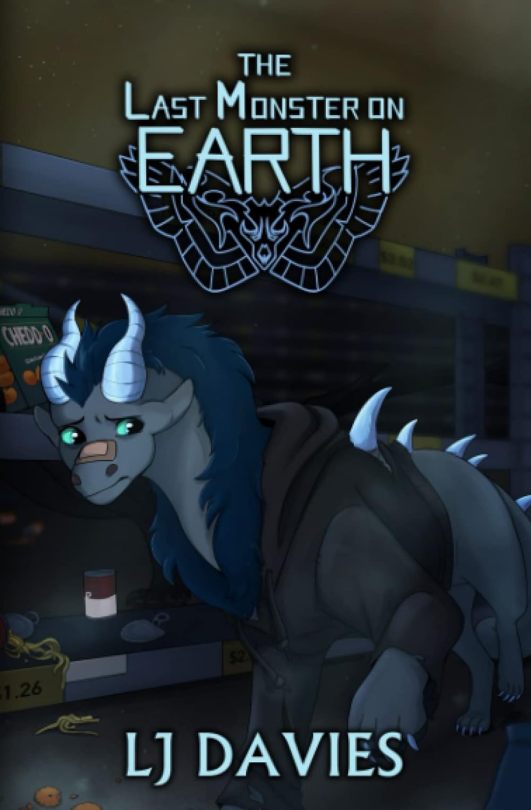
Which uses it four times in one book with examples such as “Lock these two in the truck with the cripple…”
Warriors: Forest of Secrets (book 3) has this line. “As Fireheart said goodbye to Yellowfang and went back to hunting, he felt a new surge of determination to bring Tigerclaw’s guilt into the open. For the sake of Redtail, murdered; for Ravenpaw, driven from the Clan; for Cinderpaw, crippled...”
And even Wings of Fire, one of my favourite book series uses it.
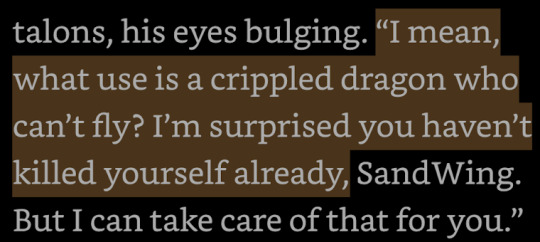
Here’s a question for you. Is it ok to use that word if the impact is meant to be insulting? In the Wings of Fire example, Queen Scarlet defeats Dune in combat, and is about to kidnap the main characters. Dune, still breathing can barley move upon which Scarlet killed him. Scarlet is one of those pure evil types of characters, this is something I could see her saying, but let’s take a step back and put your eyes in the eyes of a disabled child.
Here you are, a disabled child. You already know what the word cripple is, and it’s been used against you (don’t act like this doesn’t happen). You read Wings of Fire and you come across that sentence. What is the intent behind that sentence in the eyes of a disabled child? Are you supposed to be scared of Scarlet? Angry? Or are you upset, because even in a fantasy book with talking dragons, you can’t escape from real life or that word?
Some of you might say, “What if only the villains use that word?” While I can see Queen Scarlet calling Peril a stupid retarded motherfucker. It’s not something you want in a children's story, so why does cripple get a past?
I hope you’re getting the picture, it’s a very commonly used word, one which the disabled community has begged able-bodied people not to use. The word injured gets the same point across and it doesn’t have a history of it being a derogatory term. While replacing the word cripple with injured or severely injured isn’t a perfect fix, it’s at least getting rid of the other word which is a start at least.
Now before I continue with the other slur, I can hear some of you say you’re aware disabled people are using cripple to describe themselves. Why can’t able-bodied people use it? Here’s the thing. Not everyone in the disabled community is doing this, and it’s not a monolith. The word cripple has been used as an attack against the disabled community for decades. It targets them, puts them down, and it’s only used against them. You only use the term to refer to something as injured so there's no reason to use it on an able-bodied person. The community in which it was used against is taking that word and trying to empower it amongst themselves. You’re not gonna complain if someone who’s black uses the N-word, so why are you upset when disabled people use the word cripple to describe themselves but are saying you can’t? That word belongs to them and their community, not yours. Also, one more thing before I go, not everyone in the disabled community uses this word or wants to hear it. There have been plenty of disabled people who are fine using that word to describe themselves but won’t say it around others if other disabled people express they don’t want to hear it. So be mindful if you’re gonna use it and please hire a sensitivity reader.
Savage:
This word...I have a lot of history with it because it’s a word that’s used against my community, (indigenous) people. And yet, just like the word cripple, it’s used all the time and while it’s a very common occurrence where indigenous voices aren’t heard, we’ve been telling everyone to just drop this word. Unlike the word cripple, we aren’t trying to claim this word, we just want it gone.
The definition of this word is an easy one to understand. It’s to describe a person, object, or an action as barbaric, wild, aggressive, unintelligent, or barely even human.
Example one: “They’re savages, savages, barely even human” Disney, Pocahontas (1995). (Used against people)
Example two:DragonFire: Age of Legend (book 3) by LJ Davies
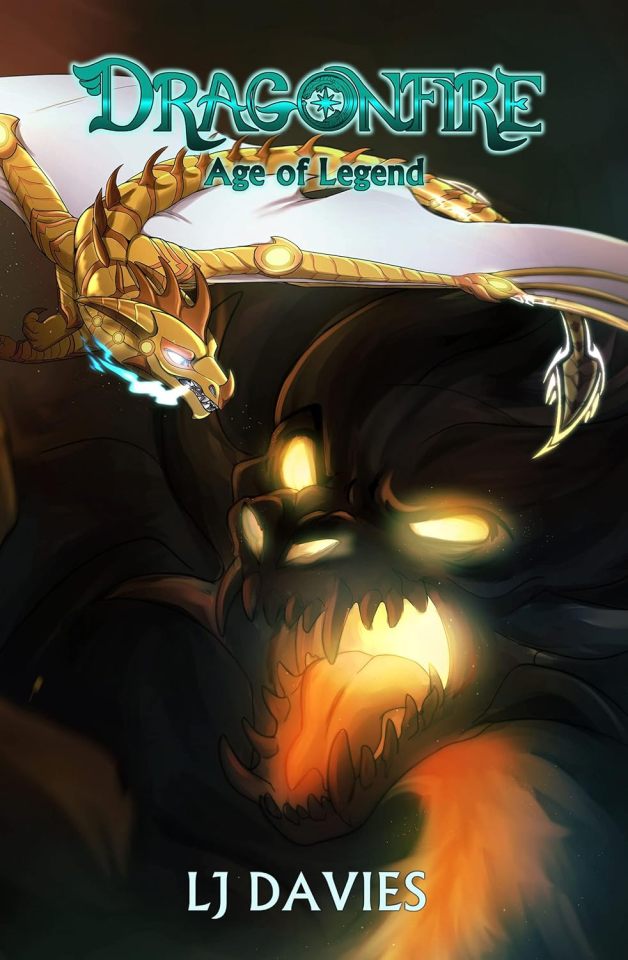
“I opened my muzzled to respond, but another savage roar drew our attention…” (Used as an action)
Example three:

(Used against a group of people)
Example four: “Savage weaponry” (Use to describe an object)
I’m gonna be using the series DragonFire a lot for my examples, because out of all the books I got, that series uses the word 19 times throughout books one, two, and three. It was used twelve times in book three and I guess someone told LJ Davies about this problem because it doesn’t appear in book four. But it DOES appear in the spin-off series “Tales of DragonFire: Rebellion” twice, and THIRTEEN TIMES in “The Last Monster on Earth”. Overall, that's THIRTY-FOUR TIMES in the course of five books, all meant for children.
LJ Davies isn’t my only example. Chester Young, used it nine times throughout books 1 and 2 of the Celestial Heir books Rowan Silver, used it once in Eyes of Silver: Dragons and Skylines (book 2) And Robert Vane, used it once in the Remembered War series in book 4
Let’s start by showing off some examples and the impact they have and please note, that this might be something you’re just not experienced with. So just like with the disabled child, try to imagine yourself as an indigenous child. You’re fully aware of the word savage, it’s been used against you, and your people. So when you read a text like “Trade with the savages...they wouldn’t understand the concept!”

It feels awfully familiar to lines you read in your history books about your people. Keep in mind, that you wanted to read a story about dragons so you could get away from real life.

(From the Last Monster on Earth by LJ Davies)
I know the United States called the Native Americans savage monsters while stealing their land, it was used as a way to justify their actions, make the natives appear barley even human or in most cases, not human at all, let’s not forget, for a good majority of the building of the United States, those founding fathers didn’t see anyone other than themselves as humans. Reading text, asking how people became savage monsters overnight should remind you how people labelled indigenous people in the past and still do today.
"To confirm the princess’s words, yes, there is an army out there whose numbers vastly exceed our own. Nevertheless, they are a crude mockery of the noble kind they once were, and they are now nothing but savages….There was a series of grunts and nods at that statement...” (DragonFire: Age of Legend, book 3)
I think, this text is a great example of what I’ve been trying to say. In this text, the character who is speaking and the grunts and nods are all dragons with human-like intelligence. They're a stand-in for us. The Elder (who spoke in said text) has been seen and viewed as one of the good guys. He calls his kind noble, and he’s working with a princess, (let’s not forget our history books on how the royal family treated indigenous people). He calls his attackers “nothing but savages”. In translation, their monsters, who are no longer noble or righteous. There’s an agreement with his statement, as if what he says is right and we should be agreeing with him.
In that sentence, understanding everyone is of human intelligence and is a stand-in for humans. We have an old white knight, calling the enemy savages while the royal family are the heroes who are trying to protect their land from those filthy, disgusting, savages. You can kind of see why I’m saying we really shouldn’t be using this word.

“Yellowfang will be allowed to stay here until she has recovered her strength. We are warriors, not savages…” Warriors: Into the Wild (book 1)
Savages...indigenous people, they aren’t warriors, they would’ve killed Yellowfang, and left her to rot in the wilds, Thunderclan is better than those monsters. Am I making my point clear enough when it comes to the history of this word, who it’s targeted against and how it comes across when reading in children's media?
You might’ve noticed I’ve mainly been using examples when it refers to a group of people, not necessarily showing off how commonly it’s used as either an action or an object because honestly...those are just kind of dumb. A savage roar? What does that mean?
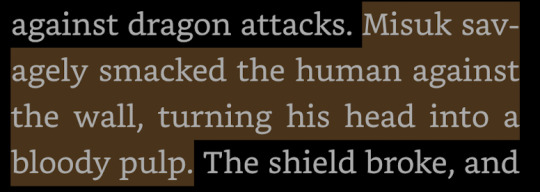
Ah yes, because we really needed the use of the word “savagely” to get the point across that Misuk just destroyed a person's skull. The “turning his head into a bloody pulp” wasn’t enough on its own. Without the use of the word savagely how else could we get the aggression and power across? When savage is used as an action it’s mostly because said character loses control of their humanity. They become savage when they attack and the end result is a bloody mess because that’s the only way indigenous, I mean, monsters, I mean barbarians, I mean savage people know how to fight. You often see these kinds of moments when the good guy who’d never hurt a fly loses control and unleashes hell, they turn into something that’s not themselves, they turned into a savage and these moments are meant to be shown as shocking as the character forgets who they are for a couple of seconds.
Indigenous people were savages, with savage strength, and a savage kind of culture. They scalp people, beat them to a bloody pulp, and ate your children. Those monsters needed to be killed. Whenever you use the word savage, it circles back to a group of minorities who were just trying to survive. This word has been used so much, that I don’t think many people realise the history behind it, which is why I said I’m not hating anyone who uses it, but please try to get a sensitivity reader. Get disabled and indigenous sensitivity readers, even if there’s no indigenous or disabled representation in your books, the words you use, still affect us and it’s a good thing to be aware of the words of which you speak and write.
Please be aware of these words, especially if you’re writing stories meant for children because the more children see these words, the more normal they’ll think it is and the more often they’ll start repeating it. I think there’s a time and place for these words, but saying them as an excuse to make something more shocking, isn’t the time or place.
#writing#writeblr#book#books#disability#disabled#writers on tumblr#dragon#writers#write#writers and poets#writerscommunity#creative writing#book writing#on writing#writing advice#writer#cw: c slur#c slur#s slur#disability in media#dragonfire sphere of eternity#dragonfire#lj davies#erin hunter warriors#Tail of revenge Celestial Heir#Chester Young#A Dragons Chains#A Dragons Chains The Remembered War#robert vane
41 notes
·
View notes
Note
About the post on writing disabled characters with a readmore from a "deactivated" account - the number of popular posts I've seen with their username marked deactivated and the same user (not deactivated) later in the thread lead me to develop the unsubstantiated theory that that's how posts that were deleted on their original blog are listed. At least sometimes. cy-cyborg dot tumblr dot com at least still exists and appears to be from someone who provides advice on writing disabled characters. (Not sure what that indicates for why the post is still readable from some directions but not all, though.)
huh. I have seen similar things and assumed OP deleted and subsequently either OP or an impersonator created a new Tumblr with the same name, but we could both be guessing right about some instances and not others, idk.
this hellsite, y'all
5 notes
·
View notes
Text
Teen Titans rewatch episode 4
⭐️ When Beast Boy’s prank goes wrong and Starfire uses a Tamaranean term I appreciate how Cyborg and Raven adopt it into the conversation instead of glossing over a word they don’t know which acknowledges their friend. For a children’s show I think little details like that in dialogue are especially wonderful!!
⭐️ Robins smile while he uses a snapped bridge rope to fly through the air 👍
⭐️ Stars ice out of Beast Boy is the perfect way to deal with him lol. I also think having Beast Boys apology be more forced by having him assume Starfire is hurt also allows room for him to make similar mistakes again in later episodes.
⭐️ Beast Boy and Thunder dreamscape + Slade in disguise + rain sequence = one of the first instances of the villains influencing the style/art decisions. In episode one we have odd looking villains and the fighting happens in dark warehouse locations. Blackfire and The Hive dont do this but think of later episodes with Mad Mod, Mumbo, etc. In this episode our villains have obvious Japanese influence (as does much of the show) but it’s highlighted more heavily with Thunder, Lightning and Slades designs.
Episode 5
⭐️ “Just because I can’t have fun doesn’t mean y’all can’t” followed by meeting a young fan with a prosthetic hand/arm 👍 this is also a characteristic choice in terms of writing. Cyborg is black but his character themes in this show are often more parallel to that of the experience of a disabled person. Metaphors about race/ethnicity and storylines with lessons about cultural differences are most often given to Starfire, the alien. Still certain lines and scenes come to mind that allude to Cyborg’s experience with his race/ethnicity and highlight it. He’s the first to pick up on and understand Starfire’s discomfort with Val-Yor and while undercover as Stone his yearning for human community, etc.
⭐️ Mumbo
⭐️ Meeting the young fan again 🤧🤧 Cyborgs character is well documented in this episode. His insecurities and longing, his love and thankfulness for friends, his appreciation for simple human pleasures like food, playing games, listening to music, being outside and using his hands, perfectly tie to the resolution of the episode; while Cyborg has robotic limbs, his heart and mind are that of a human and his body helps make his personal human experience complete.
Episode 6
⭐️Starfire, Beast Boy, Cyborg, and now Raven! The most introverted of the group leaves Ravens character feeling more mysterious (aided by her cape and magical powers of course) During breakfast clean up Starfire says “there is much about her we are not meant to understand” and I find this estimation of Ravens character by her really nice. It’s not just that Raven is gothic and quiet, but Starfire is more well versed with unusual un-earthly creatures and perhaps recognizes this part of Raven.
⭐️ This mirror is maybe??? the first indication that Raven isn’t just a person who uses magic, but a magical being from another world. Of course Cyborg and Beast Boy are chosen to go into Ravens mind because 1. That’s the funniest combination but 2. Cyborg in episode 3 has a line about how Raven bottles up her emotions, and at breakfast his comment about leaving her alone is of good intentions but not as insightful as Robins “she’s our friend what else do we need to know” or Starfires “not meant to understand”. He’s more understanding than Beast Boy of course, but Cy would gain the most benefit from this venture vs Star or Robin development wise.
⭐️ “For the hundredth millionth time we forgive you!”
⭐️ “Now you’re a marine!?”
⭐️ This shits so crazy like wdym your dad is locked away inside your mind and also he’s a towering red demon. Also her becoming white Raven is so sick. I also like how the summation of her personality is represented as her usual blue. When Trigon transforms into a Raven and rejoins her, the white cloak goes away and our regular Raven is there. With her white cloak Raven is idealized, she is herself without the burden of her father. But he’s integral to her being, her past/family history deeply shapes who she is and that’s okay 👍
⭐️ Robin holding Starfire back is a good “bridge” moment for him. The whole teams exchange at the end is really sweet though
1 note
·
View note
Text
writing disabled characters by submalevolentgrace
the truth about prosthetic arms by champutee
writing amputees by diane morrison
5 tips for writing amputees by cy the cyborg
the wikipedia page for prosthesis obviously
tiny little page that shows the different types of below elbow prosthesis
overview of limb prosthetics by jan j. stokosa (make sure you look through the whole page for this one. it's full of information)
keep in mind i linked the second last article about below elbow prosthesis because this is in relation to gordon from hlvrai. let me know if any of the links are broken, the wrong link, untrue, ableist, or something of the like. i do not want to spread misinformation about a topic i do not have personal experience in. always ask someone who has the same issues that the character does if you are confused. always do lots of research in general.
if you would like to add onto this list, reblog this post with the links you have :)
im not an amputee but good fucking god the hlvrai fandom sucks at depicting gordon with a prosthetic in post-canon situations. please. if you are going to give him a prosthetic do some research oh my godddd. give him recreational attachments pretty please i never see people talk about that. talk about phantom pain. etc.
at some point im probably gonna make a masterpost about good resources for info on writing characters with prosthetics. if i remember.
83 notes
·
View notes
Text
Trainer Quest #14
Framing Question(s): How are these episodes connected? As teachers can we use popular culture to engage these abstract topics of violence & vulnerability?
These two episodes are related because they both contain people that possess immortal powers. Both the characters abilities are also challenged either by injury (the Legend of Korra), or by a weird talk show host, as seen in the Steven Universe episode. They both start to feel discouraged and incapable but then are able to overcome their obstacles and find their strength again. As teachers we can definitely use popular culture, such as tv shows, to engage these abstract topics of violence and vulnerability. By using popular culture to introduce and discuss these topics with our students its helps these issues appear more relevant to the students. It will help keep them engaged because its something they enjoy doing, watching tv.
In Kafer’s reading, it starts off by saying “Donna Haraway insists that the cyborg is about both pleasure and responsibility” but then Kafer goes on to absolutely destroy Haraway by saying “Pushing the figure from a disability perspective entails bringing a disability consciousness to the cyborg, attending to the specific benefits and dangers it harbors for disabled people. This shift requires an acknowledgment that human/machine interfaces are not always beneficial or pleasurable; an awareness that many disabled people lack access to the cy- bertechnologies so highly praised in cyborg writing; an accounting for the ways in which cybertechnologies rely on disabling labor practices across the globe; and a realization that not all disabled people are interested in technological cures or fixes. Each of these elements takes cyborgology away from its traditional use of disability as metaphor, and toward an un- derstanding of disability in political and social context. In so doing, they also-and ironically-bring cyborg theory closer to the promise of Har- away's manifesto, a promise of a fully situated cyborg that refuses easy celebrations of human/technology connections.” I really enjoyed this part of the reading because I love watching people get dragged and called out on their bullsh*t.
PROMPT: Doodle an animated cartoon to relax.
Sorry mine’s so bad, its not easy to draw on a laptop tracker pad...

1 note
·
View note
Text
Disability Tropes: The Perfect Prosthetic

[ID: A screenshot from the movie Nimona, showing Nimona, a small white girl with red hair, grabbing the right prosthetic arm of Ballister, a knight in black armour with black hair and light brown skin. He is holding a broken bottle in his prosthetic hand while Nimona admires his arm. Overlaid on the screenshot is white text that reads "Disability Tropes: The Perfect Prosthetic" /End ID]
In a lot of media, prosthetic limbs are portrayed as these devices that act as a near-perfect replacement for a character who has lost, or was born without a limb. So much so that in a lot of cases, the use of a prosthetic has basically no impact on the character beyond a superficial level or their appearance, or it's portrayed as something that's even better than the old meat-limb it's replacing. This trope shows up most often in Sci-fi, but it shows up in all kinds of stories outside of that, even otherwise very grounded ones!
If a story isn't depicting the loss of a limb as the be-all-end-all worst thing that can happen to a person, they almost always default to a perfect prosthetic, functionally curing the amputation with it. But the reality is that prosthetics are FAR from perfect, and as someone who has used them for their entire life I don't think they ever will be. Limb difference is still and always will be a disability, regardless of the prosthetics available, and this really isn't a bad thing.
Why is this trope so common?
I meant it when I said this is a really, really a common trope, so much so that the majority of the media I've seen with amputees and characters with limb differences that released in the last decade or end up using it. Even stories where becoming an amputee is treated like a fate worse than death, ironically, aren't excluded from this. I have a few theories as to why this has happened: The pessimistic answer is that it's easy. You get to have a disabled character and claim you have disability representation, without really having to do much extra work or research because most of your audience won't notice if you aren't accurate - in fact they kind of expect it. You also, for the most part, dodge the backlash other kinds of disability representation (or really any minority representation) usually get. The more optimistic reason is that, for a long time, amputees and people with limb differences (as well as a lot of other disabled people) were predominantly shown in media as sad, depressed and unable to do anything, very much falling into the "sad disabled person" trope. As a kid, this was really the only way I saw people like me on screen or in books. And so, the limb difference community pushed back against that portrayal and were pretty successful in changing the narrative in the public's eye. A little too successful. A lot of creatives were genuinely trying to do right by our community, listen and do better, but many simply overcorrected and instead ended up creating stories where prosthetics were essentially cures instead of the mobility aids they are. I also think the public's general lack of understanding about disability plays a roll in all this. There are a lot of people who, in my experience, believe that the more visible a disability is, the worse it is. Limb differences and amputations are very visible, but prosthetics, even those that aren't trying to be discreet, make them less so. While using a prosthetic is very, very different to a biological limb, you won't necessarily see how in a casual interaction with, say a co-worker or neighbor, especially because there is a very real stigma applied to people with limb differences to keep those things hidden from the public. There are other reasons too, such as the fact that a lot of creatives don't even consider the connection to real amputees when creating characters with robotic limbs in genres like sci-fi and some fantasy, so they never stop to consider that these tropes could be impacting real people. Amputees are also very frequently used in "inspiration porn" content that uses the angle that disabilities can be "overcome" with a good attitude, downplaying the way those disabilities actually impact us. The prosthetics industry - specifically the component manufacturers, often also push the idea of prosthetics being the only way to return to a "normal" life, both to the wider public and to people with limb differences and amputations (which can add to that sense of shame I mentioned when it doesn't play out that way for them). On top of that, I also think the recent increase in popularity of concepts like trans-humanism contributes to it as well. these movements often talk about robotic or bionic body parts being enhancements and "the way of the future", and I think people get a bit too caught up on what may be potentially possible in the future with the real, current experiences of people with "robotic limbs" aka prosthetics, now. There are also inherently disabling things that come with removing and replacing parts of your body, things that will not just go away with some fancier tech.
So How do you actually avoid the trope?
So, we have some ideas about why it happens, but how do you actually avoid the "perfect prosthetic" trope from appearing in your work? The most important thing is to remember that this is still a disability. The loss of a limb, even with the best prosthetic technology or magical item in the world, will always have some inherently disabling aspects to it - and this is not a bad thing. The key is to not over-do it, lest you risk falling into the old "sad disabled person" trope. So let's go over some of the ways you can show how your character's disability impacts them. You don't have to use all of these recommendations, just choose the ones that would best fit your character, their circumstances and your setting.
The prosthetic itself is just different
Probably the most important thing to address and acknowledge for prosthetic-using characters, is the actual ways in which the prosthetic itself is different from a biological limb, and the drawbacks and changes that come with that. For the sake of simplicity, I'm mainly going to focus on modern prosthetics here, but it's worth considering how to apply this your own, more advanced/fantastical prosthetics too. One major thing that most people writing amputees fail to acknowledge is that prosthetic limbs are not fleshy-limbs with a different coat of paint. They do the same basic thing their meat-counterparts do, but how they do it is often drastically different, which changes how they are used. A really good example of this is in prosthetic feet. There are dozens of joints in a biological foot, but most prosthetic feet have no joints or moving parts at all. Instead of having dozens of artificial joints to mimic the real bone structure of a foot, which are more prone to failure, require power and make the prosthetic much, much heavier for very little gain, prosthetic feet are often constructed from flexible carbon fiber sheets inside a flexible rubber foot-shaped shell. This allows the bend and flex those bones provide, without all the drawbacks that come from trying to directly mimic it. Making the sheets into different shapes makes them more ideal for different activities. E.g. feet made for general use, like walking around the city, are simple and light, shaped to encourage the most energy-efficient steps, while still allowing their users to do things like wear normal shoes. Feet made for rough terrain often have a split down the middle of the foot to allow the carbon fiber sheets to bend better over rocks when there is no ankle, and some newer designs also include a kind of suspension using pressurized air pulled from the prosthetic socket to allow some additional padding. Running feet have large "blades" made of these carbon fiber sheets to absorb more pressure when the foot hits the ground, and redirect the force that creates to propel their user forward as quickly as possible.

[ID: A photo of 4 prosthetic feet. On the left, the foot is covered with a black shoe, the one to it's right consists of a small, carbon fiber blade, split down the middle, in roughly the same shape and size as the previous foot. Next to the right is an even simpler and smaller carbon fiber foot with no split, and finally is a very short foot that is vaguely rectangular in shape. /End ID]
These are some of my own prosthetic feet I've had over the years. The two on the right are designed to be used by someone who is less mobile, and the ones on the left are made for someone who is more active. As my needs changed over the years, I've used different designs and styles, and keep the old ones since my needs do tend to fluctuate.
There are also robotic feet available that are designed as a kind of "all-purpose" foot that use an electronic ankle which more closely mimics a biological foot, but they are not very popular as the mechanism adds a lot of extra weight and it requires a battery and power to work, with many amputees feeling the jointless carbon fiber feet do a better job at meeting their needs. The same goes for arms and hands. "Robotic" hands that mimic a meat hand exist, but they aren't really that popular, even in places like Australia where the prohibitively expensive price tag isn't as much of an issue due to government programs that pay for the device for you. Instead, most arm amputees who use prosthetics that I know prefer simpler devices that do specific tasks, and just swap between them as needed, rather than something that tries to do it all. A big part of this is because the all-purpose hands can be clunky. they often require manual adjustment using the other hand to do simple things like going from holding a deck of cards to putting them down and picking up a glass of water, for example. The few that don't require that, I've been told, are often temperamental and don't actually work for every person with a limb difference.
Altered Proprioception
Loosing a limb is a big deal and this is always going to have an impact on the body in some way that won't be solved with a fancy piece of tech. One such example is how limb loss effects your sense of proprioception. This is your sense of where your body parts are in space. It's how you (mostly) know where your foot is going to land when you're walking, or how you're able to do things like lift up a glass of water without needing to actually watch your hand do it. Your brain does this by creating a mental map of your body, but this map doesn't get adjusted if you loose a limb. If that map doesn't accurately reflect your real body, you're not going to have an accurate sense of proprioception. This might look like a leg amputee being a bit less stable on their feet, or like an arm amputee needing to look at their arm or hand to be able to grab something with it. Those born without their limbs who take to using prosthetics often have a lot of trouble adapting, as their brains aren't used to having that limb in the first place, whereas an amputee's brain can sometimes be tricked into using their outdated body map to help them adjust to the prosthetic (though its impossible to line it up perfectly). Prosthetics that directly integrate with the nervous system, while rare, do exist, and even this direct connection doesn't completely erase this issue for reasons doctors aren't quite sure about. This is something that does become less of a problem with time. Eventually, someone proficient with their prosthetic will learn to compensate, but their sense of proprioception will never be 100% perfect. At the end of the day, no matter how it attaches, a prosthetic is still not a natural part of the body, and that will always cause some issues. It also means if they aren't practicing it all the time, they may have to relearn how to compensate for it.
Extra weight
You also have to remember that a prosthetic is not a natural part of the body, like we already talked about, and so no matter how good it is, your brain will most likely always interpret the weight of the prosthetic as something attached to you, not part of you. This means that, even though prosthetics are actually a lot lighter than biological limbs, they feel so much heavier. This is because, while a meat limb is heavier, a lot of that weight is from muscles which are actively contributing to the limb working, so it doesn't really feel like its that heavy. When you have less of your meat-limb though, you have even less muscle to work with to move this big thing strapped to it, so it feels heavier. The more of the limb you've lost, or just didn't have, the heavier the prosthetic has to be, and the less muscle you have left to move it. It's for this reason that a lot of amputees and people with limb differences get tired faster when using prosthetics. Some of us are fit enough where you almost wouldn't notice the extra effort they need to put in, but once again, just because you can't see it from the outside, doesn't mean it's not an issue.
Avoiding Water
Most prosthetics also aren't waterproof, and so prosthetic users have to be very careful about when and how they come into contact with it. For amputees with electric components, contact with water at all will likely damage the device. This can even include especially heavy rain, something I was told to avoid when I got my electronic knee prosthetic and something I assume would also apply to arm amputees with complex, electronic hands. For those with non-electronic prosthetics, water can be hazardous for different reasons. If the prosthetic has metal components, water may cause them to rust, especially if it's salty water. Other prosthetics have foam covers to give the illusion of a limb with the general shape of muscles and fat, but these covers do not come off, and if they get wet enough that water seeps all the way through, it is very hard to dry it and they may become moldy. Finally, cheaper modern prosthetics may also float. Many are made of very light-weight materials and some have pockets of air trapped inside them. For leg prosthetics in particular, this means a user might, at best, struggle to swim with them on, but at worst, may get flipped upside down and become trapped underwater - something that happened to me as a very young child. On the flip-side, older prosthetics were usually made of heavy materials like wood or steel, and so had the opposite problem, acting like a weight and pulling a person down if they were to wear them in the water. Water-safe prosthetics do exist, I had a pair of prosthetic legs as a teenager that were hollow, and designed especially for me to swim with fins on when swimming in the ocean, and Nadya Vessey, a double leg amputee in New Zealand even got a mermaid-tail prosthetic made especially for use in the water. Most amputees though just swim without any prosthetics at all, and in 99% of cases, this is the easiest and safest way to go.
Prosthetic-Related Pressure Sores and Pain
Many people with limb differences also experience pressure sores from their prosthetics. Modern prosthetics typically attach to the body using a socket made of carbon fiber or fiberglass, held on either by pressure, using a vacuum seal or through a mechanical locking system built into the socket. No matter the specifics though, the socket has to be very tight in order to stay on, and this means that extended periods of use can lead to rub-spots, blisters and pressure sores. Many socket prosthetics also use silicone liners to add extra padding, but this means wounds caused by the pressure can't breathe, and bacteria in sweat has nowhere to go, meaning if the person doesn't rest when one of these wounds occur, it can very easily and quickly turn into a serious infection. In a properly fitting prosthetic, used by someone who has fully adjusted to them, this doesn't happen often, but it is something most amputees and people with limb differences have to at least be mindful of. Some new prosthetics use a different method of attachment, called Osteointegration - where the prosthetic attaches to a clip, surgically implanted into the person's bones. While Osteointegration avoids many of the issues like pressure sores that come from a socket, they have their own issues: mainly that they are incredibly expensive, and as of right now, have a pretty high failure rate due to the implant getting infected. Because the implants are directly connected to the bone, these infections become very serious very quickly. Many people with Osteointegration limbs have to be on very strong medication to keep these infections at bay, and they are generally considered unsuitable for anyone who is going to regularly come into contact with "unclean" environments.
Maintenance

[ID: A screenshot of Winrey, from Full Metal alchemist Brotherhood, a white woman with blond hair handing out the sides of a green hat. She is measuring a piece of metal from a prosthetic she is making while Ed, the prosthetic's owner, gives her a thumbs up in the background. /End ID]
Finally, prosthetics also require maintenance from a specialist called a prosthetist, and they don't last forever. Some parts, like a foot or hand, can be reused over an over, but the sockets of a prosthetic need to be completely remade any time your body changes shape, including if you gain/loose weight, you start experiencing swelling, or you're just a child who is growing. Children in particular need new prosthetics every few months because they grow so fast, and as such, their prosthetics have to be made with this growth in mind. If they go too long without adjustment or an entirely new prosthetic, it can seriously impact the child and their growth but even small adjustments can be costly, depending on where you live. While prosthetics are built to be sturdy and reliable, they need a lot of work to stay that way. The more complex the prosthetic, the more work is needed. Complicated electronic components may need to have regular maintenance done by your prosthetist or even the specific component's manufacturer, and depending on where you live, this might mean having to send your prosthetic limb away for this to be done. While my prosthetist technically has the skills and knowledge to do the maintenance on my electronic knee, for example, the manufacturer forbids anyone not from their company to provide this service, meaning my leg needs to be shipped off to Germany once every few years if I want to keep the warranty. This has the unfortunate side effect of sometimes your limbs getting lost in postage (shout-out to Australia Post, who lost mine twice), meaning it can be months before you get it back or get a replacement. Usually, you'll be given a replacement in the meantime if you need it, but walking on a leg that isn't yours, even when its correctly fitted, always feels a bit weird (maybe that's just me though).
Not every difference is Inherently Negative
We've talked about some of the negatives that come from having a prosthetic, but not every difference is negative or even really that big of a deal. In fact, often times, it's these little moments in the depiction of a disability that go the furthest and make it feel the most genuine. My amputations effect me from the moment I wake up, to the moment I go to bed, but that doesn't mean every single way it impacts me is always inherently bad or negative. For example, back when I was working a normal job and going to university, I would often come home, throw my legs off at the door with the shoes still attached and get into my wheelchair, the same way you might throw your shoes off after work and replace them with comfy socks and other comfy clothing. This is something I've only ever seen on screen once, with Eda from the Owl House (and she wasn't even an amputee yet, her limbs were just detachable)

[ID: an screenshot of Eda from the owl house, a very pale woman, laying on the couch in a bathrobe, her hair in a towel. She has taken her actual legs off, throwing them to the other side of the seat. /End ID]
After that, my day mostly looked the same as most other people working a 9 to 5, I'd make myself dinner, watch some TV or play some games, maybe do some extra work at my desk or chat with friends. The only difference is that it would all be from a wheelchair, mainly because my prosthetics were heavy and it was just easier to use the chair around the house. The fact my afternoon and evening routine was done from a wheelchair wasn't a bad thing, it was just different. Likewise, I also don't sleep or shower with my prosthetics on, for the same reasons most other people wouldn't take a shower or sleep in thigh-high, steel-capped boots. In your own stories, this might look like giving your characters similar alterations to how they go about their day. Let them take their arm or leg off when they're resting or relaxing, show them taking a few minutes longer to get ready because they have to put it back on, show them doing some things without it. Arm amputees in particular tend to get very good at going about their days without their arm prosthetics, and leg amputees often either learn to get around more relaxed spaces like their homes using a different mobility aids like wheelchairs or crutches, or just through hopping if that's something they're physically able to do. Even when everything is going well and working as intended, your limb-different character won't wear their prosthetic 24/7, no matter how much they love it. There doesn't have to be something wrong with it or painful about it to not want it glued to them at all times, just like you can love a pair of big heavy boots but not want them on when you're trying to sleep. For more action-focused stories, being an amputee, also changes things like how you fight. The specifics will vary from person to person, but for example, when I did Hap Ki Do, a Korean Martial art, my instructor heavily modified when I learned what techniques. Beginner-level kicks and most leg attacks were impractical for me, as the force from the kicking motion would usually cause one of my legs to fly off. I also couldn't jump very well, due to some complications with my original amputation that made my stumps too sensitive to withstand the force of landing again. So I ended up learning a lot more upper-body attacks much earlier than it is typically taught. By the time I got my green belt, I was practicing upper-body techniques usually saved for black belts - including weapons training that I could use my secondary mobility aids for, like crutches and my cane in a bad situation. Many holds that rely on creating tension in your target are also less effective on amputees, because either the anatomy that causes those holds to be painful just simply isn't there, or the body part in question can just be removed to escape. Whether we're talking about the negative things, or just neutral differences that come with using prosthetics, you don't want to go too far with any one example. The key is to strike a balance. Of course, the old writing advice of "show don't tell" also applies here. It's one thing to tell us all of this stuff, but unless we actually see it play out, it won't mean much.
How NOT to avoid the trope
Before we move on, let's focus for a moment on some common things I've seen that you SHOULDN'T do as a way to get away from the trope.
The Enhanced Prosthetic
A lot of sci-fi in particular will take prosthetic limbs, make them function exactly the same as a biological limb, but add something extra to it. This does change the way the prosthetic functions and is used, but it usually still ignores the actual disabling parts of having a prosthetic. A really good example of this can be seen in pretty much any futuristic setting, but personally, I think Fizzeroli, from Helluva Boss is the best one to demonstrate what I mean. Fizz is a quadrilateral, above knee/above elbow amputee with highly advanced prosthetics that function, more or less exactly like the limbs he lost, but with the added benefit of being super-stretchy. Fizz is an acrobat and a clown in service, at least initially, to Mammon, one of the Seven Deadly Sins. These prosthetics help him perform and we even do see how they change little things like how he walks and just goes about his day, but the show still treats them like natural arms and legs, but better.

[ID: A screenshot of Fizzeroli from Helluva Boss, a white-skinned imp with 4 black, prosthetic limbs, dressed in teal a nightgown as he lays in bed, reading from a list /End ID]
We see that he never takes them off, even when sleeping, and when he needs to use them as regular arms and legs, they do everything he needs, perfectly fine - at least when they're working correctly. The only time he ever even takes them off or has any issues with them, is when they break in season 2. The word amputee is never used to describe him, as far as I remember, and the fact he is one never really comes up at all, except for when they break or when the story focuses on how he lost them. Which brings me to my next point.
The Glitchy/Broken Prosthetic
One way I see people try to avoid the perfect prosthetic trope, is to take the prosthetic and break it or otherwise make it unreliable by having it malfunction, but not really changing anything else. This approach is heading in the right direction but still kind of misses the point of the criticism a lot of limb different folks have with the depictions of prosthetics in the media. Yeah, prosthetics do break down and some do require extra maintenance, but if your character's prosthetic is still exactly the same as a biological limb (or even better, in the case of the "enhanced prosthetic") when it's not broken, and the only time their disability is treated like a disability, is when it breaks, you're not really addressing the issue. Real prosthetics, like we discussed, even when functioning at 100%, exactly as the manufacturer intended, don't function the same as a meat-limb. They are fundamentally different, and the glitchy/unreliable prosthetic completely ignores all of that. Once again, Fizz is a really good example of this - the only time his prosthetics are not perfect, is when they break or are malfunctioning (despite the criticism, I do genuinely love Fizz as a character, but he unfortunately does fall into a lot of disability tropes).

[ID: Another screenshot of Fizzeroli, this time in a torn up jester outfit, looking down, panicked, at his prosthetic arms which are fully extended and laying motionless on the ground, with his left arm visibly short-circuiting with electricity around it. /End ID]
Now this isn't to say you can't have your character's prosthetics break down or malfunction at all. just that this shouldn't be the only way you differentiate the prosthetic from a biological limb. You should also be mindful of how or why they're breaking. A typical prosthetic isn't going to break down randomly from normal use unless something is very, very wrong or your character just has a terrible prosthetist (which unfortunately, does happen). You might experience issues if you try to make the prosthetic do something it just wasn't designed to do, or expose it to something it wasn't designed to deal with though (e.g. submerging an electronic prosthetic in water and trying to use it to swim).
Just add Phantom Pain
Another common pitfall I see when people are trying to avoid the perfect prosthetic trope, is to just give the character in question phantom pain - which is a side-effect of amputation where your brain's mental map of the body doesn't acknowledged you lost a limb. Your brain tries to fill in the gaps, since there is no signals coming from that part of the body anymore, and assumes either something must be wrong and so you should be in pain, even when you actually aren't. Alternatively, it can also happen when your brain was so used to feeling pain from that area before, in the case of people who had chronic conditions before they lost their limb, that it just keeps remaking those old signals itself. Like the broken/glitchy prosthetic approach, this also doesn't really address the issue with the perfect prosthetic trope, because it has nothing to do with the prosthetic itself. Phantom pain doesn't come from the prosthetic, nor does it effect how they're used, and so including it doesn't really address the issue of the prosthetic being functionally the same as the original, biological limb. This isn't to say that you shouldn't include phantom limb sensation or pain as something your character experiences, but just keep in mind that, when used on it's own, it doesn't counter the trope. Also, just be sure to do your research, everyone's experience with phantom pain is different and it's not something everyone with a limb difference even experiences.
Why is this trope even a problem?
Alright, so we know what the trope is, we know why it became so prevalent, ways to avoid it and also how not to avoid it. All good information, but why is this trope even bad? Why should you try to avoid it? Outside of just wanting to portray a real disability that effects real people more accurately in your creations, the prevalence of this trope actually contributes to a lot of real-world issues, especially when it's as overused as it currently is. I've talked before about "the jaws effect" - where the depiction of something in the media, especially something that the public is widely uneducated on, influences how people see it in real life. The Jaws effect specifically referred to how the popularity of creature-feature movies featuring sharks, like Jaws, caused the belief that sharks were monstrous killing machines to become much more wide-spread, even going so far as to influence decisions about laws and policy surrounding real-life shark preservation and culling in some parts of the world. But sharks aren't the only thing this has happened to.
Disabled people are so thoroughly misunderstood by wider society, that when tropes like this one become popular, people can and often do start to believe the misinformation they spread - in this case, believing that our prosthetics are a perfect replacement for a biological limb, and that getting a prosthetic means you're not disabled any more. While this can be annoying and cause small scale issues for some of us, like people giving us a hard time for using disability accommodations we very much need, it can also impact us in systemic ways too. If the wrong people believe these tropes, it can and does have a very real impact on the lives of disabled people through things like changes to policies to make it harder for amputees and people with limb differences to access financial assistance for other things outside of our prosthetics we may need assistance with.
Conclusion
Despite the very real harm tropes like this can do when it's overused, I don't think it should go away entirely. Some of my favourite pieces of media even use the perfect prosthetic trope and there are even some kinds of media where I even think it's somewhat unavoidable. Characters with perfect prosthetics in kids media in particular, especially when talking about side characters, can help to correct some of the other stereotypes kids may have seen elsewhere - such as prosthetics being "creepy" or "scary" - in a way that is casual and easy for them to understand. The problem with the trope, in my eyes, is it's excessive overuse. It's the fact that it seems to be the only representation amputees and people with limb differences are getting now. Not every story with a limb-different character can or even should delve into the reality of what using prosthetics is actually like, but we need at least some stories that do, without it being this majorly depressing thing.
#Writing disability with Cy Cyborg#Disability tropes#Long Post#Disability Representation#Writing Disability#Writing#Writeblr#Authors#Creators#Writing Advice#Disabled Characters#On Writing#Disability in Media
3K notes
·
View notes
Text
Forgetting your character is disabled isn't a "good representation" flex: Writing Disability Quick Tips
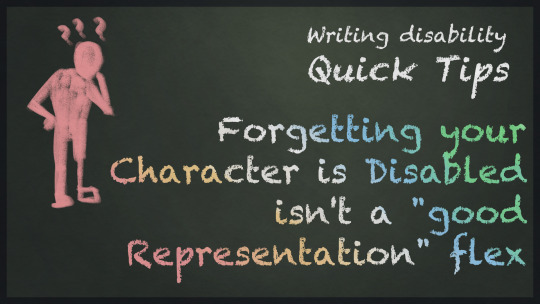
[ID: An image with “Writing Disability quick tips: Forgetting your character is disabled isn't a good representation flex” written in chalk the colour of the disability pride flag, from left to right, red, yellow, white, blue and green. Beside the text is a poorly drawn man in red chalk looking down confused at his leg, one is drawn normally, the other is drawn to resemble a basic prosthetic. He has question marks above his head. /End ID]
For a while, I was involved in the booktok and Tik Tok writing communities, specifically parts of the community focused on more diverse books and authors. During this time, I noticed a reoccurring pattern when people were highlighting stories featuring disabled characters, or even promoting their own books, and that was how often people would say "I kind of forget they have [insert disability here] because they're such a badass."
The intention behind this statement is (usually) good, with people trying to show that their disabled characters are self-sufficient and don't fall into the tired old sad/helpless disabled person trope, however, you can - and very much should - do that without erasing your character's disability. If you find yourself forgetting your character is disabled, or your beta and pre-release readers are commenting about forgetting it, then there's a good chance that's exactly what you've done - and as a disabled person myself, if I see that statement being used in your marketing in particular, it's a giant red flag and a sure fire way to make sure I give the book in question a skip.
Remember, disabilities (especially major ones) are a part of your character's identity, and they're important regardless of the character's personal relationship with it. Even if your character doesn't specifically identify with the label of disabled or doesn't really care that much, it's should still be impacting their daily life, even in small ways. If you're finding yourself forgetting about a major part of your character's identity, it might be a good idea to check and make sure their disability is having an impact on the character.
I see this comment most often with amputee characters, and to me, it's a pretty consistently good indication that the author has treated their character's prosthetic as a cure rather than the mobility aid it is. It's far from unique to amputees, mind you (I talked about this a lot when I was discussing the character of Toph from Avatar), but it's when I tend to see it the most. Remember that mobility aids and other forms of assistive technology and assistive magic (if it's a fantasy story) are just that: they're aids, they assist, they shouldn't be cures.
Of course, this wasn't unique to Booktok, I've seen it on nearly every other social media site with a writing and book-focused community at some point, but Tik Tok was just where I spent the most time and it seems to be where I see the most people specifically gloating about it.
#Writing disability with Cy Cyborg#Quick tips#Disability#Disabled#Disability Representation#Writing Disability#Writing#Writeblr#Authors#Creators#Writing Advice#Disabled Characters#On Writing#book marketing
1K notes
·
View notes
Text
This is just a not-so friendly reminder to non-disabled people, especially authors, people in fandoms or in media analysis circles: Cripple/crippled is not just a fancy way of faying "badly injured". it's not an adjective you can just throw in to spice up your sentence because you used "injured" or "disabled" too many times in that paragraph, or because you feel like it gives your writing some extra "oomph".
Cripple is a slur.
A slur the physically disabled community has been asking people not to use for DECADES, since at least the 1970's (50 years). It's a slur with centuries of abuse behind it, centuries of being used to justify physically disabled people as less-than, centuries of demonisation, mistreatment, ostracization, and murder.
Some people within the physical disability community are reclaiming it, that's where movements like cripplepunk (also known as crip-punk or C-punk) come from. That's fine, I'm not talking about that. I love the cripplepunk movement and everything it stands for: being unapologetic about our disabilities and not changing ourselves for the comfort or convenience of able-bodied folks. But the people who use it in that context understand the history of the word, they know how it was used to hurt us, and they understand that not everyone in the physically disabled community is comfortable with the use of the word, especially those who were around when someone being labelled as "crippled" was seen as a valid reason to treat them as less than human. They understand the impact of the word.
But If you, as an able bodied person, casually uses "cripple" in your work, at best you are showing your disabled audience that you haven't been listening to us, at worst, you show you don't care about weather we feel safe in the spaces you have created.
And for able-bodied authors specifically, even if your character is physically disabled, I'd still recommend avoiding it unless you're prepared to do a LOT of sensitivity readings from multiple sensitivity readers. I've been physically disabled since I was 1 year old, I learned to walk for the first time in prosthetics and have been using a wheelchair since I was in school, I have no memory of life as an able-bodied person, and even I don't feel comfortable using the word cripple in my work.
It's a loaded word, with a lot of implications and a LOT of very dark, and for some people, very recent history. It's not a sentence enhancer to just throw in willy-nilly. Please.
#Writing Disability with Cy Cyborg#disabled#disability#disability history#ableism#physically disabled#cripple punk#cpunk#actually disabled#physical disability#visibly disabled#visible disability#writing disability#writing#writing community#writeblr#writers of tumblr#authors of tumblr#media analysis#write#c slur#language
3K notes
·
View notes
Text
Tips for writing and drawing Wheelchair using characters: Your character's wheelchair can tell us a lot about them
When you first start learning character design, you'll often be told something to the effect of "use your character's outfit to tell us more about them" - and this same principles can be applied to a disabled character's mobility aids.
Mobility aids like wheelchairs, to many disabled people, are a part of us. They can be an extension to a person's body and chances are, if you're going to be using this piece of equipment every day for the foreseeable future (or at least for a good amount of time for the foreseeable future), it's going to start reflecting some aspects of your personality, your interests, your passions, especially when you remember, a lot of people get their wheelchairs custom built for them.
You can use your character's wheelchair to tell us a lot about them without ever needing to show/describe them directly.
Let me show you two examples:
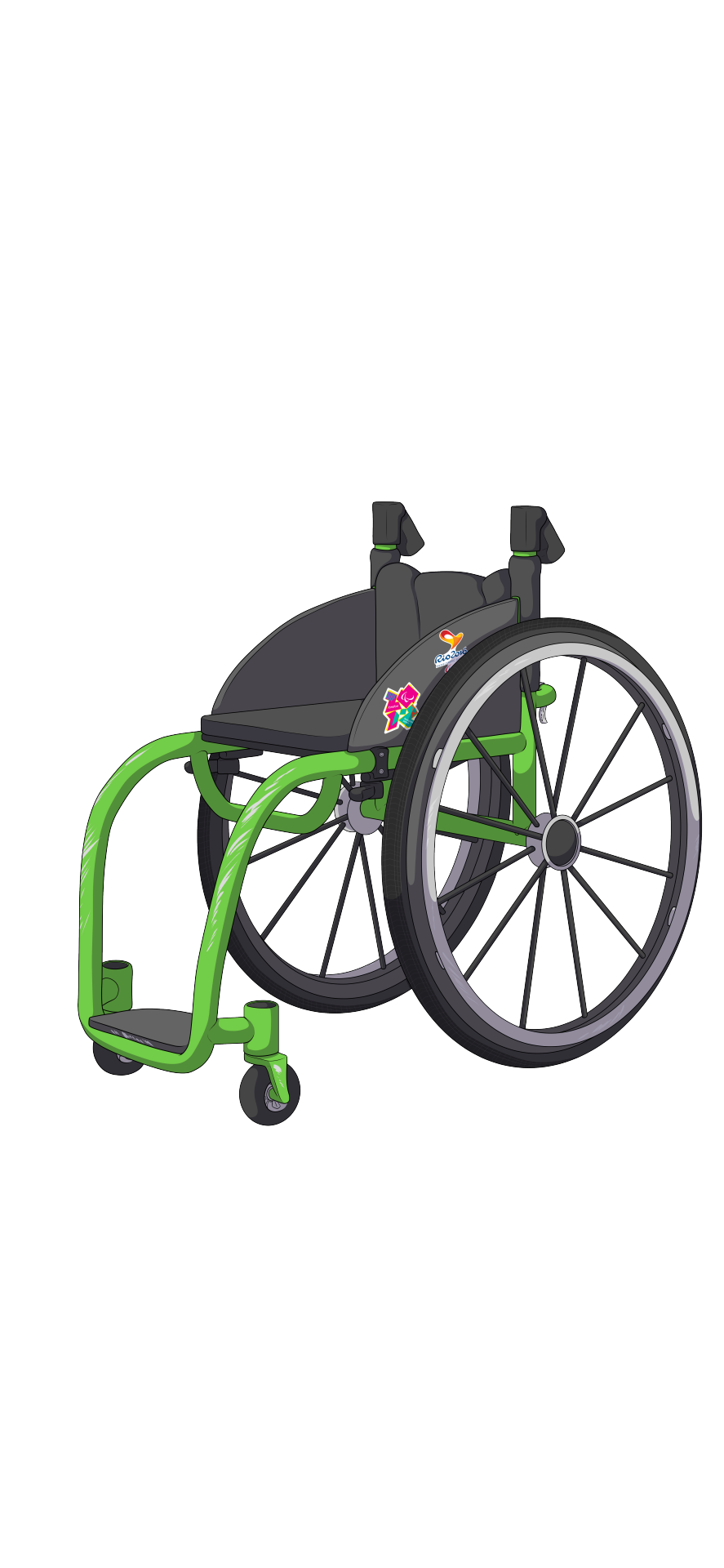
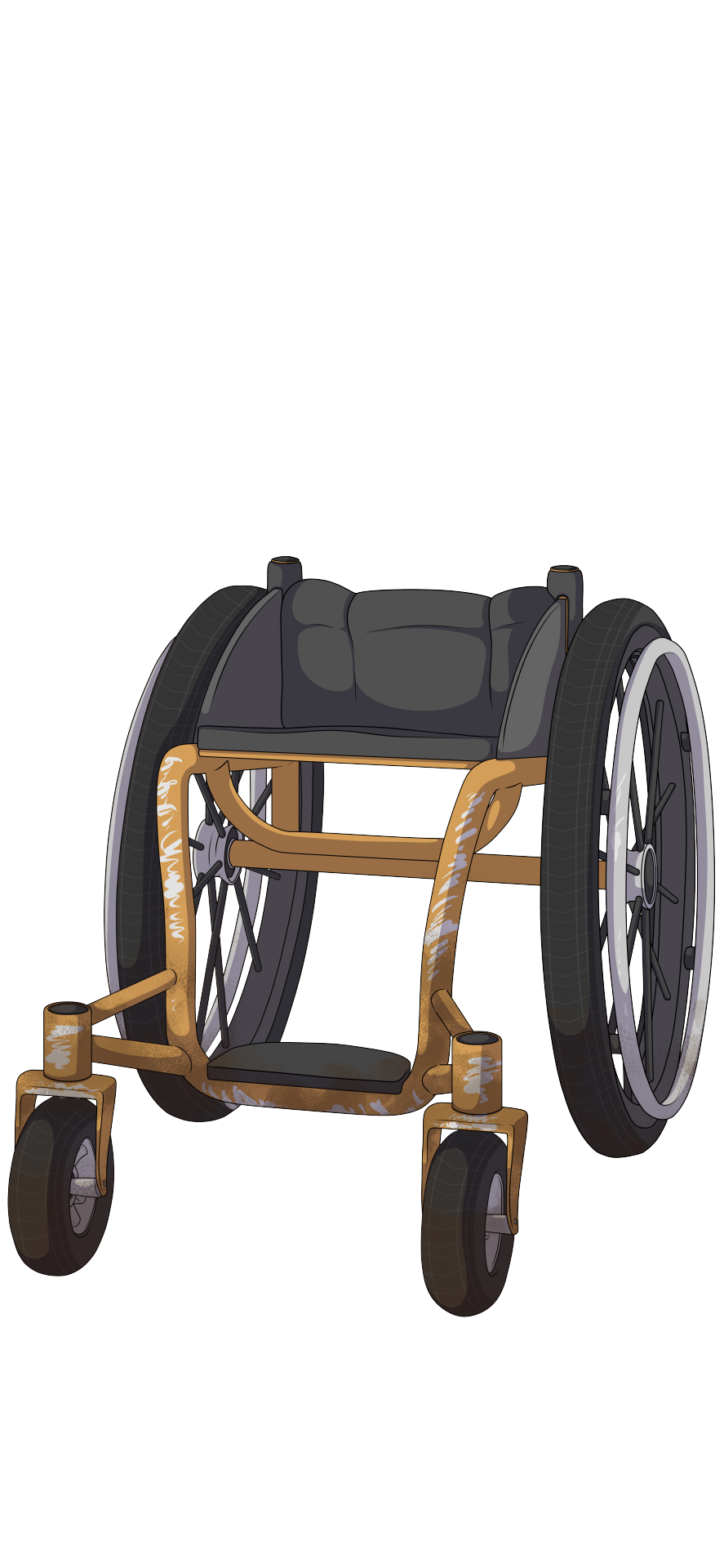
Take a look at these two wheelchairs. they're similar in shape and build, but still pretty different to each other. Can you make some guesses about their users based only on what's shown here?
intended answers below:
Please note, the following points are all generalisations and the real world is rarely this simple. This is to demonstrate how to use disability aids to contribute to your character's design, not how to make assumptions about real people in real life.
So here are some similarities between the chairs:
Both wheelchairs have ridged frames, this means the wheelchair can't be folded in any way. These kinds of chairs can imply a few different things depending on the person. They are typically lighter, sturdier and more durable, and indicate the person probably will be using the wheelchair for a long time and/or has the money to get something built to last (or lives in a place where cost not an issue due to universal/subsidised access to healthcare). They are also typically better to travel with when flying, as they are less likely to be broken by airport security/staff.
Both wheelchairs also lack anti-tip wheels, which are a third set of wheels that extend from the back of the chair. Them not being present could indicate the person is likely pretty confident in their ability to use the chair without worrying about tipping out. It could also indicate they are in an environment where the anti-tips could be more of a hazard than a help, such as on rough terrain.
So lets look at some specifics for the green wheelchair:
Take a look at the wheels. The front wheels are pretty small and appear to be solid, while the back wheels appear to be quite narrow (compared to the orange chair anyway). This indicates the user likely lives somewhere with decent accessibility like a (well funded) city where they are unlikely to encounter unpaved/dirt roads/grass. Small front wheels and thin back wheels are good for manoeuvrability and a smooth ride over even terrain, but they will get stuck as soon as bumps appear, so this probably isn't an issue for this person.
While its a bit hard to tell unless you have seen other similar wheelchairs, this wheelchair is very long in the front, meaning the footplate and front wheels are further away from the seat than most. There could be a few reasons for this. One either indicates the person has very long legs, or a lack of motion in their knees, making it harder to bend their legs. This is moves the chair's centre of gravity forward by a decent amount, making it harder to tip back, which could indicate the person's legs are very light. You tend to see this most often in the wheelchairs of bilateral leg amputees, who are at a greater risk of tipping backwards due to a lack of weight at the front of the chair (even if they wear their prosthetics).
The colour of the chair is bright. This could simply be the character's favourite colour, or maybe this colour has some significance to them?
There are stickers on the side of the chair relating to the Paralympics. This could indicate the person is a fan, or perhaps had some involvement in the games?
The wheelchair has handles on the back, but they are able to be folded down. This is a popular feature for people who are independent enough to go out on their own, but still want to have the option for some help. folding down the handles also deters random strangers from grabbing at you (an unfortunately common experience for wheelchair users).
There is some mild paint scratching to the front of the wheelchair, but nothing too noticable. This is typical of older chairs and people who are a little rough on their chairs. Maybe they've had a few stacks and falls throughout the years, probably going a decent speed.
Ok, now let's look at the orange chair
This wheelchair has very large, inflatable front wheels, and very thick back wheels. This will make the chair slower and less manoeuvrable on flat/even surfaces, but much, much easier to push on rough terrain. This is supported by the amount of mud on the wheelchair.
The seat on this wheelchair tilts upwards slightly. This is called a bucket (or according to an old basketball teammate of mine, a dump-truck lol). This is a feature you typically see in wheelchairs made for people with spinal injuries who are unable to move their legs and engage their lower bodies or core to help keep them stable.
The back of this chair is very low, indicating that if this wheelchair user has a spinal injury, it's probably pretty low on their spine, likely fairly close to the hips, making the person a low-level paraplegic. Higher-level paraplegics and quadriplegics usually need a higher back to help support them and keep them from flopping over, since all the muscles below their place where their spine broke either doesn't work, or is significantly weaker. Higher backs though can get in the way of pushing and reduce mobility, so people who need less support will likely opt for a lower back rest.
This wheelchair has no handles, which indicates the user is probably very independent and doesn't need a lot of help getting around.
The paint on this wheelchair is very scratched up, showing the person is very tough on their wheelchair and doesn't care to get the paint touched up.
This wheelchair has no breaks. This is very common on chairs with larger tiers as they don't tend to be as effective, but also on many outdoor wheelchairs, for two reasons. One is because they are made for rough terrain, so chances are, you aren't going to go far without a big push to get you moving. The second reason is that to get over large bumps and obsticals in a wheelchair, it can be helpful to do very large pushes using the top and front of the wheel. When pushing a normal chair, most people will only use the top section of the wheel to push since it's closest, but these big pushes that use the front of the wheel make it easier to push, since you can benefit from downwards momentum. However, this is also where the breaks are located on most wheelchairs, which can create a hazard. I've lost entire fingernails by them getting snagged on the breaks when pushing this way. So if you live somewhere where the breaks are not going to be helpful to you often, it makes sense to not get them.
And here are the characters who own these wheelchairs
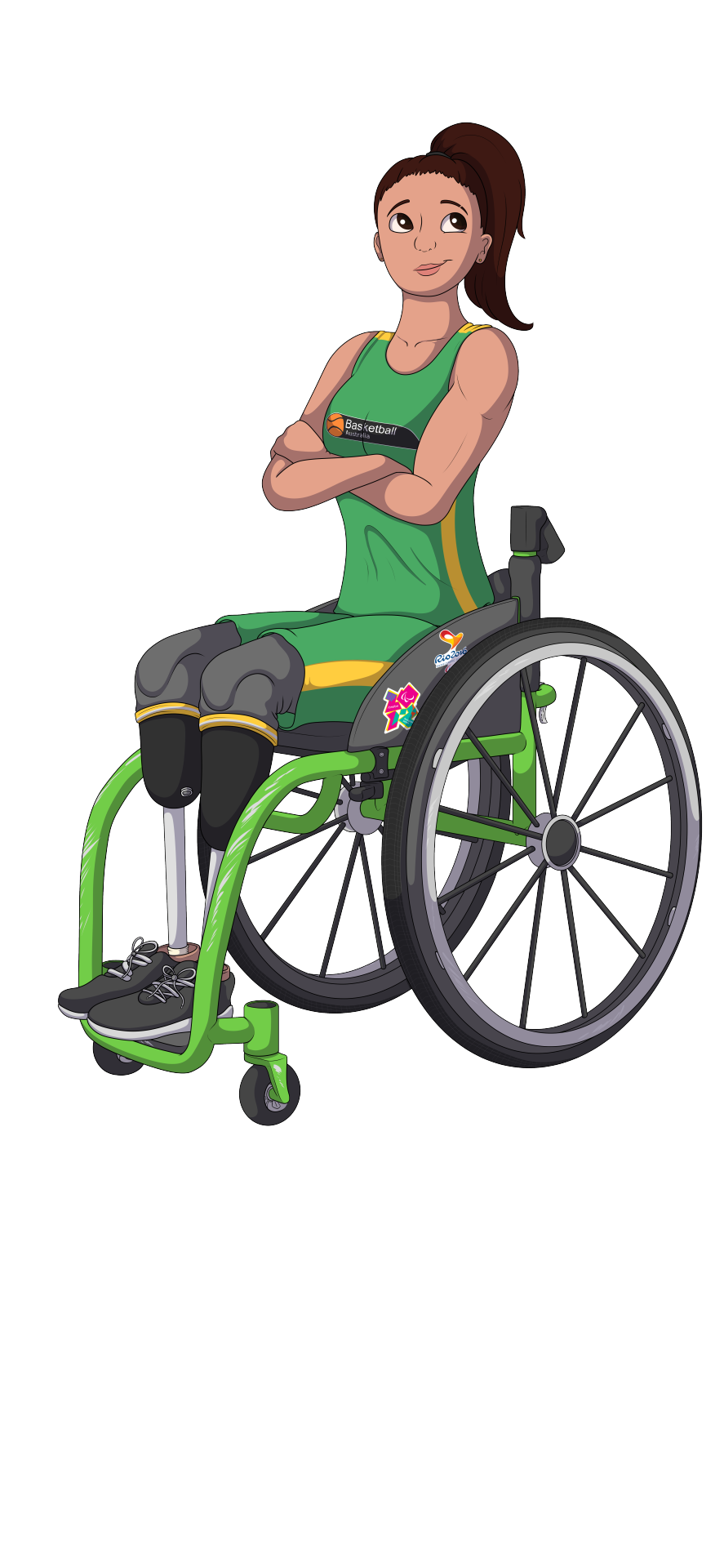
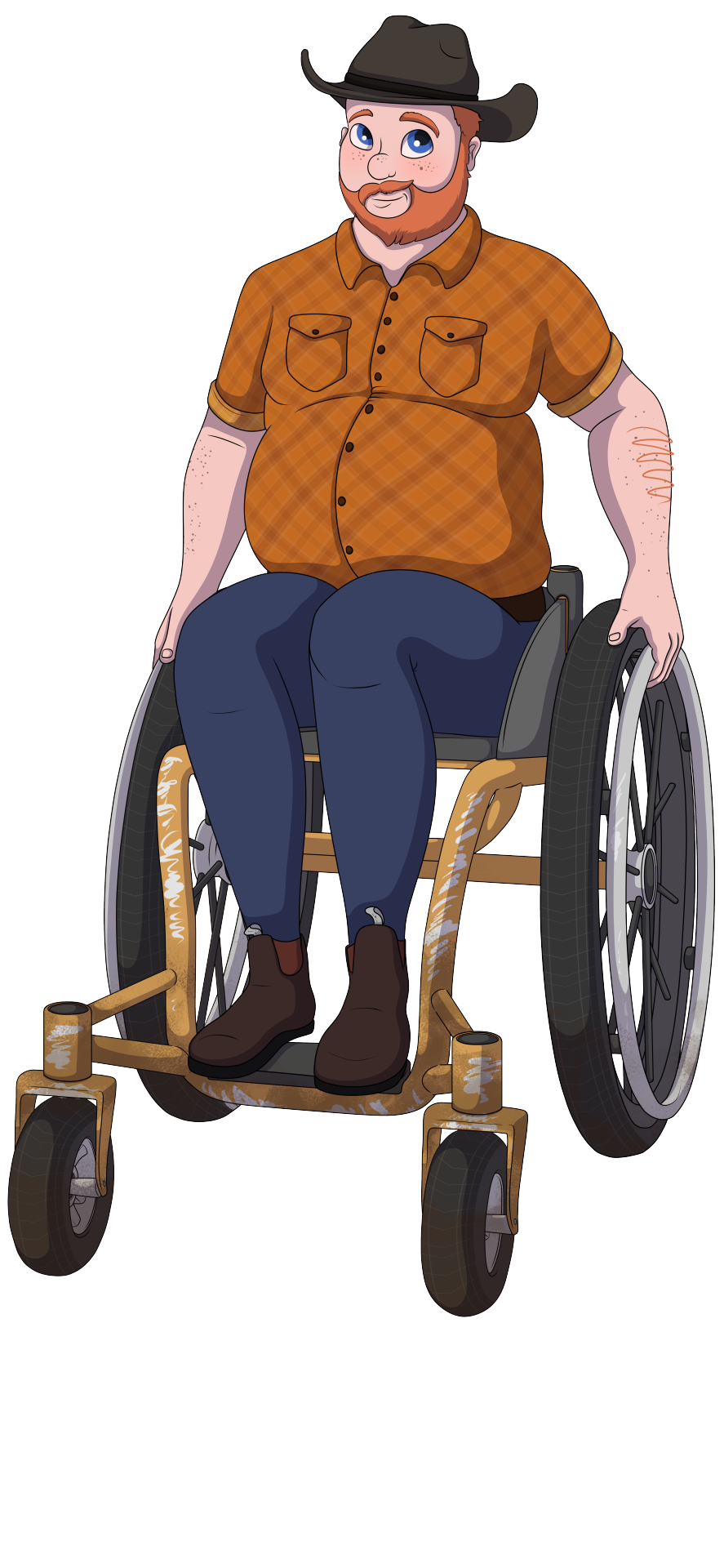
The owner of the green wheelchair is an amalgamation of a few people I knew from when I played wheelchair basketball. They're a bilateral leg amputee, and judging by their outfit (The Official National Wheelchair Basketball uniform for Australia), they're an elite athlete. This wheelchair is not the one they play sport in, but it still needs to be durable enough to withstand the rough treatment of airport staff when traveling, as well as heavy day-to-day use that comes with being an active person. While it needs to be rough, the person also seemed to want to prioritise speed and manoeuvrability, and likely doesn't need to worry about rough terrain too much, so they probably live in a major city.
The owner of the orange chair was inspired by a family friend of mine. They live on a farm, and need a chair that can handle life in those conditions, rough terrain and all. This comes at the cost of speed and manoeuvrability on smoother terrain, but honestly, anyone who's lived in the country knows you won't find many of those around there anyway, so that's not too big of a sacrifice. They are paraplegic, are very confident in their ability to use their wheelchair, and probably doesn't need help too often, but still benefit from some extra stability support from the raised seat on their chair.
Conclusion
Once again, these are generalisations, and in real life there are always exceptions, but I hope this helped demonstrate what I meant when I said you can use your character's wheelchair to tell us more info about them if you're smart about it.
I originally planned to do a whole series of these, showing a wider variety of wheelchairs and the people who they belong to, but I guess I kind of forgot because they've been sitting, abandoned on my hard drive for the last 2 years 😅. If that's something you folks would be interested in seeing though, let me know, I'd happily revive the series lol.
#Writing Disability with Cy Cyborg#id in alt text#long post#writing disability#disability#disabilities#disabled#physical disability#wheelchair user#physically disabled#wheelchair#character design#character illustration#character concept#Designing Disabled Characters#writers on tumblr#writing#writing community#writblr#writerblr#writing advice#writing tips#writing resources#art reference#artists on tumblr#artblr#illustrator#visibly disabled#disabled and proud
4K notes
·
View notes
Text
The Jaws Effect and what it means for media representation
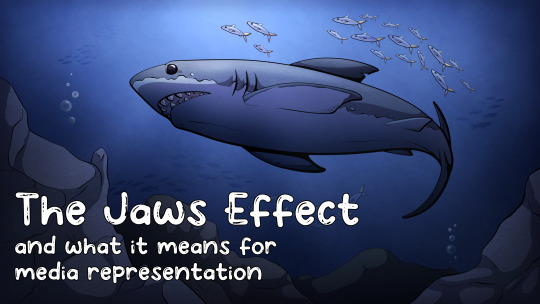
The Jaws Effect is the name of a phenomenon that described the panic and fear that sprang up around sharks, fuelled by Steven Spielberg's movie, Jaws. While the fear of sharks and other marine predators had always been a thing, Jaws launched the fear of sharks, and Great White Sharks in particular, to new (and mostly unfounded) heights. Most people will never encounter a real-life shark and so their only knowledge about the creatures come from movies and other forms of entertainment. Entertainment that largely portrayed them as mindless, unfeeling killing machines. After Jaws, sharks became a staple in the creature-feature genre of movies, which only perpetuated the idea of sharks as dangerous monsters even further, reigniting and reconfirming the beliefs the public held about them in the process. These ideas about sharks are, of course, not true, but the misconception and fear has had a real, observable impacts on shark populations, shark conservation efforts and even laws and legislations surrounding sharks and shark conservation around the world.
Ok but Cy, this is a blog about disability and disabled representation, what do sharks have to do with anything you talk about? Well, Because The Jaws Effect is just one of many examples that shows how massive of an impact representation in the media can have, for better or for worse, especially when talking about subjects the public generally knows very little about.
This conversation is not unique to disability representation, nearly every person I've seen who's talked about how to write and design characters from any minority brings it up eventually, but the media we consume, the movies we watch, the books we read can all have big impacts on people's perceptions on those topics. When talking about disability specifically, it's an unfortunate reality that not many people know all that much about us, and so, much like sharks, for many, their only real exposure to disabled people is through the media they consume.
If you don't know anyone in a wheelchair, and your only knowledge of life as a wheelchair user comes from books and movies like Me Before You, of course you're going to (spoiler) come away thinking that life in a wheelchair is horrible and death is better than living like that. If you don't know any DID Systems and your only exposure to a condition like that is through movies like Split (and honestly, a number of other horror movies and crime shows) of course you'll think people with DID are unstable monsters who could become violent any moment. If your only exposure to autistic people is Music, then it's not shocking that you might think Autistic people are "trapped in their own minds," completely unaware of the world around them and lacking any kind of agency. As much as I'd like to be able to say these are "just movies" or "just books," and that if we don't like them, we can just not watch them, they all had an impact on the real world and real people's perceptions of the disabilities they depicted, as do the many, many smaller examples of bad representation.
This is why I personally spend so much time focused on the portrayal of disability in the media, why so much of my content is focused on creating resources for creators to represent us better, and why I think writers, artists and other types of creators should care about the representation they include.
Unfortunately, people believing misinformation and stereotypes, while annoying, isn't the worst of the impacts bad rep can have. If a stereotype is prevalent enough, and enough people believe it, it can both put us in harms way and cause us to loose access to things we desperately need and things designed to help us. One really common example of this is when movies and TV shows show a character getting up out of their wheelchair, and use this as proof that the person is faking being disabled. However, in reality, there are many disabilities that might mean someone has to use a wheelchair, even if they can still walk a little bit or stand up. The stereotype of someone standing up from their chair being a fake, especially when it's reinforced over and over again in the media, leads non-disabled people to believe that anyone who stands up from their wheelchair is faking, and results in a lot of real disabled people being harassed and denied things like access to disabled parking, toilets and other accessible spaces. There were even a few cases of people reporting those they see get out of their wheelchairs to Centrelink (The Australian "welfare" department, for those not familiar) as frauds, and while these investigations don't usually go far before someone realises what's happened, it has, on occasion, resulted in people loosing the income they depend on to survive, even temporarily.
But the impact of representation, of course, can go both ways.
I was in high school when the first How To Train Your Dragon movie came out, and at the time, I didn't really like people being able to see that I was a leg amputee because I was sick of kids in particular staring, pointing at me, asking their parents "what's wrong with them?" or asking me directly, "what's wrong with your legs?". I wore long skirts and big, bulky tracksuit pants to keep my legs covered, something that became dangerous in the hot Australian summer, but I didn't care.
But the impact of How to Train Your Dragon came in two ways. The first, was that it was one of the first times I'd seen an amputee (or rather, multiple amputees) who didn't keep their prosthetics covered or hidden, and it gave me the little boost in confidence I needed to do that myself and wear clothing that was more comfortable and functional. And second, the comments from children changed, albeit slightly, but enough that it was noticeable. The questions and comments went from "what's wrong with you?" to "oh cool, your legs are like Hiccup's!" I even had one little girl ask me once if I had a pet night fury. They went from being scared of me and my legs, or at the very least concerned for me, to genuinely curious and impressed. While reactions like that did become less and less common over time, they didn't fully go away either. Even today, I occasionally get young kids asking me why I have legs like hiccup. A friend of mine who was born with one arm shorter than the other and without fingers on that side had a similar experience with the movie Finding Nemo. Her disability was a bit more complex than what I described here, and she always found it hard to explain "what happened" to small children, however, after Finding Nemo came out, she was able to simply tell kids "this is my lucky fin, like what nemo has!" and that was enough to take her from someone "scary" to these kids to someone like their favourite characters.
Of course, it's much easier to see the impact positive representation can have on people's perceptions when we're talking about kids media, but it's not exclusive to it either.
When it comes to a minority like the disabled community who are so thoroughly misunderstood by the wider public, misinformation can and does spread easily. What people see and read in the media they consume plays a big roll in how people perceive the real people attached to the stereotypes. We often hear people say "Fiction imitates life" but the reverse can and often is also true, life can imitate and be influenced by fiction, and those of us creating should be mindful of this, especially when we're talking about a group of vulnerable people.
[Thumbnail ID: An illustration of a Great White Shark swimming near the rocky bottom of the ocean, surrounded by silver fish. In the bottom left corner of the image is "The Jaws Effect and what it means for media representation" in big, white bubble text. /End ID]
#Writing disability with Cy Cyborg#Disability 101#Long Post#Disability#Disabled#Disability Representation#Writing Disability#Writing#Writeblr#Authors#Creators#Writing Advice#Disabled Characters#Disability History#On Writing#Disability in Media
1K notes
·
View notes
Text
Writing and drawing amputee characters: Not every amputee wears prosthetics (and that's ok)
Not every amputee wears prosthetics, and not doing so is not a sign that they've "given up".
It's a bit of a trope that I've noticed that when an amputee, leg amputees in particular, don't wear prosthetics in media its often used as a sign that they've given up hope/stopped trying/ are depressed etc. If/when they start feeling better, they'll start wearing their prosthetics again, usually accompanied by triumphant or inspiring music (if it's a movie). The most famous example of this is in Forest Gump, Where Dan spends most of the movie after loosing his legs wishing he'd died instead. He does eventually come around, and him finally moving from his wheelchair to prosthetics is meant to highlight this.
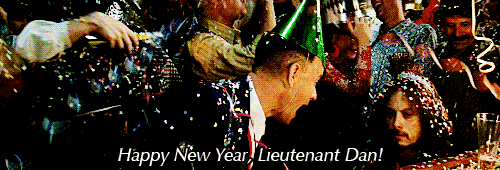
The thing is, it's not that it's unrealistic - in fact my last major mental health spiral was started because one of my prosthetics was being a shit and wouldn't go on properly, despite fitting perfectly at the prosthetist's the day before. I'm not going to use my legs when I'm not in a good headspace, but the problem is, this is the only time non-prosthetic using amputees ever get representation: to show how sad they are. Even if that's not what the creator/writer necessarily intended, audiences will often make that assumption on their own unless you're very careful and intentional about how you frame it, because it's what existing media has taught them to expect.
But there are lots of reasons why someone might not use prosthetics:
they might not need them: this is more common in arm amputees because of how difficult it can be to use arm prosthetic, especially above-elbow prosthetics. Most folks learn how to get on without them pretty well. In fact, most of the arm amputees I know don't have prosthetics, or only have them for specific tasks (e.g. I knew a girl who had a prosthetic hand made specifically for rowing, but that's all she used it for).
Other mobility aids just work better for them: for me, I'm faster, more manoeuvrable and can be out for longer when I'm in my wheelchair than I ever could on my prosthetics. Youtube/tik tok creator Josh Sundquist has said the same thing about his crutches, he just feels better using them than his prosthetic. This isn't the case for everyone of course, but it is for some of us. Especially people with above-knee prosthetics, in my experience.
Other disabilities make them harder to use: Some people are unable to use prosthetics due to other disabilities, or even other amputations. Yeah, as it turns out, a lot of prosthetics are only really designed for single-limb amputees. While they're usable for multi-limb amps, they're much harder to use or they might not be able to access every feature. For example, the prosthetic knee I have has the ability to monitor the walk cycle of the other leg and match it as close as possible - but that only works if you have a full leg on the other side. Likewise, my nan didn't like using her prosthetic, as she had limited movement in her shoulders that meant she physically couldn't move her arms in the right way to get her leg on without help.
Prosthetics are expensive in some parts of the world: not everyone can afford a prosthetic. My left prosthetic costs around $5,000 Australian dollars, but my right one (the above knee) cost $125,000AUD. It's the most expensive thing I own that I only got because my country pays for medical equipment for disabled folks. Some places subsidise the cost, but paying 10% of $125,000 is still $12,500. Then in some places, if you don't have insurance, you have to pay for that all by yourself. Even with insurance you still have to pay some of it depending on your cover. Arm prosthetics are even more expensive. Sure, both arms and legs do have cheaper options available, but they're often extremely difficult to use. You get what you pay for.
they aren't suitable for every type of environment: Prosthetics can be finicky and modern ones can be kind of sensitive to the elements. My home town was in a coastal lowland - this means lots of beaches and lots of swamp filled with salty/brackish water. The metals used in prosthetics don't hold up well in those conditions, and so they would rust quicker, I needed to clean them more, I needed to empty sand out of my foot ALL THE TIME (there always seemed to be more. It was like a bag of holding but it was just sand). Some prosthetics can't get wet at all. There were a few amputees who moved to the area when I was older who just didn't bother lol. It wasn't worth the extra effort needed for the maintenance.
People have allergies to the prosthetic material: This is less of a problem in the modern day, but some people are allergic to the materials their prosthetics are made from. You can usually find an alternative but depending on the type of allergy, some people are allergic to the replacements too.
Some people just don't like them.
There's nothing wrong with choosing to go without a prosthetic. There's nothing wrong with deciding they aren't for you. It doesn't make you a failure or sad or anything else. Using or not using prosthetics is a completely morally neutral thing.
Please, if you're writing amputees, consider if a prosthetic really is the best mobility aid for your character and consider having your characters go without, or at least mix it up a bit.
For example, Xari, one of the main characters in my comic, uses prosthetics unsupported and with crutches, and uses a wheelchair. They alternate between them throughout the story.
#disability#disabled#id in alt text#writing#writing disability#disability representation#authors of tumblr#write#writeblr#writers on tumblr#writerscommunity#writer#creative writing#writing tips#writing resources#writing help#writing advice#writing disability with cy cyborg
3K notes
·
View notes
Text
Tips for Writing and Drawing Amputees: Bandaged Stumps
When writing and drawing amputee characters, unless your character only just lost their limb, they don't need to wear a bandage over their stumps.
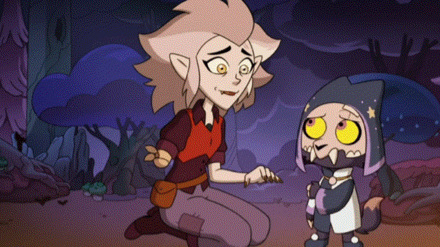
to be clear, eda's depiction in the show was fine, since she'd only just lost her arm and went (presumably) without any medical attention, but because the show didn't have much time to show her afterwards, I've noticed a tendency of the fandom to draw her wearing the bandage permanently, so that's why I'm picking on her for my example lol.
It's a bit of a trope at this point, and I think it comes from one of a few different places:
Amputees do wear bandages on their stumps, but usually only for the first 6-12 weeks post-amputation, sometimes longer if the amputation was a result of a burn. It's possible people saw this though and assumed it was permanent.
Most amputees wear a sock made of either cotton or silicone under their prosthetics to provide them with some extra padding. These socks, called liners, often stick out from the top of the prosthetic socket and could possibly be mistaken for a bandage from a distance.
Some amputees will wear compression garments for a few months to a few years after their amputations which could also be mistaken for a bandage from a distance. These garments are designed to stop swelling and reduce phantom pain, but they aren't bandages.
Stumps get cold easier because their circulation typically isn't as good as the rest of the body, so some amputees will wear socks over them even if they aren't wearing a prosthetic to keep warm, which again could be mistaken for a bandage from a distance.
This one is funny, but in my experience unfortunately, it's the most common: people think the end of an amputee's stump is just a perpetual open wound that never heals. Meaning to avoid "gore" it needs to be covered. I've met fully grown adults who believed this until I showed up to work/uni without my prosthetics or socks on.
People are uncomfortable with seeing an uncovered stump and so put bandages over it to avoid confronting their biases.
Some combination of these points.
But yeah, unless your amputee has only just lost their limb in the last few weeks, they don't need a bandage.
The ironic thing too, is that for most amputees, bandaging a stump is nearly impossible. I've been in and out of hospital since I was 1 year old and only ever met 3 nurses and no doctors/surgeons who could successfully bandage my stump in a way that the bandage would even stay on. This is because stumps are usually tapered in shape (meaning they are wider at the top, closer to the body, and thinner at the bottom), so gravity will pull the bandage off 9 times out of 10.
On a final note: it's ok to show your amputee's stump, it's not gore, there's no blood, it just looks like a regular limb that just stops early. In fact, if you are writing/creating anything for kids or that is likely to be seen by kids, I encourage you to show your amputee's stumps at least once. I used to work on a disability awareness program for kids, and I lost count of the amount of times kids were terrified of me, because they all expected my leg to be bloody and gory. For a lot of kids, I was their first real-life exposure to an amputee, meaning they'd never even heard of people like me, or they had seen an amputee on TV, but because the show went out of its way to avoid showing the person's stump, they assumed it must have been because there was "something scary at the end" that they weren't supposed to see (kids are surprisingly perceptive, they will pick up on stuff like that without you realising). And scared kids aren't good at articulating why they're scared, and would often say really mean or hurtful things to me. I knew not to take it personally and learned how to handle those situations, but not everyone is used to dealing with kids. For a new amputee (or anyone who's less confident in their disability), the kinds of things those kids would say could be absolutely confidence destroying. I never blame the kids, it's not their fault, but the whole situation could have been avoided if they had seen people like us before they had the chance to hear the wrong info. Good representation like this can be the difference between a kid crying, making throw-up sounds and calling an amputee "disgusting monsters" (all things I've had kids do/say) and them just being like "oh ok, cool."
#Writing Disability with Cy Cyborg#writing disability#disability representation#disabled#writing advice#writeblr#authors of tumblr#writing#authors#writer#on writing#writers on tumblr#writblr#writerblr#creative writing#character design#amputee#amputee representation#artists on tumblr#designing disabled characters#oc#oc art#ocs#original character#artists#character design tips#art tips#art resources#art reference
2K notes
·
View notes
Text
Tips for drawing and writing amputees: The prosthetic needs something to hold onto
Prosthetics need to be able to hold on to the body.
If you're giving your amputee something similar to 99.99% of modern prosthetics, this will be done through a socket. This is a ridged cup made perfectly for the amputee that holds the prosthetic onto the body. Older prosthetics (mostly anything before the 90's) made the prosthetic socket intentionally tight in spots, which is what held it in place. Some people with sensitive skin still use this style of prosthetic but they've mainly fallen out of use in favour for suction sockets. These sockets create a vacuum seal that holds the prosthetic in place. These can work in two ways, either just by forcing excess air out of the socket and creating the seal that way, or for some legs, sucking that excess air out and into an "ankle" mechanism to offer some extra suspension and padding in the step.
Some prosthetics will also use additional measures as well as suction, such as pin-locks, where the amputee wears a sock with a screw at the bottom that clips into a mechanism at the bottom of the socket, or a prosthetic with movable panels that can be tightened via cables running through the socket.
I've used all of these except the pin lock socket, and they all have one thing in common: The sockets need as much space as possible. For prosthetics using suction in particular, this is to spread out the amount of force being applied to the leg. If all the suction is being applied to the end of the stump, it's going to get sore and could even damage the skin. If that same amount of suction is applied to a much wider area, it's going to feel less intense. Likewise, older prosthetics needed as much space to work with as possible too, as applying tight pressure to a small area as opposed to a larger surface to keep the tension isn't good for your skin or muscles in that spot.
For this reason, the sockets will take up all of the space available without limiting movement, meaning they will go all the way up to the next major joint. An amputee who lost their hand through the wrist will have a socket that goes all the way to their elbow. An amputee who lost their leg through or above the knee will have a socket that goes all the way to their hip.
Sometimes, if an amputation is particularly close to a major joint and there isn't a lot of space left between the stump and the next major joint, prosthetists will opt to immobilise the closest joint and take the socket all the way up to the next major joint. This was something I've actually discussed with my prosthetist. My left leg is amputated below the knee, but I only have a few centimetres of space below the knee. That leg occasionally needs revisions, meaning they take the very tip off of the stump to help correct issues with weird bone growth, scarring, infections etc, but if I get another revision, my leg will be too short to comfortably wear a socket, so my knee will need to be immobilised and my leg will become, functionally, an above knee amputation, despite still having the joint. This is rare, but it happens on occasion, showing that sometimes that need for space trumps even the use of a still functional joint. It's really important.
I wanted to bring this up because I see a lot of people draw sockets on their amputee's prosthetics, but they're much too tiny to be comfortable!
I did mention most prosthetics use a socket, but not all do. Some old prosthetics did not have sockets and were held in place using other methods.
This is a "prosthetic" my prosthetist found in his company's back room. He's not sure when it was made, but together we came up with an estimate of it being made around the 70's for a through-hip amputee (meaning someone who's whole leg was amputated with no stump at all)
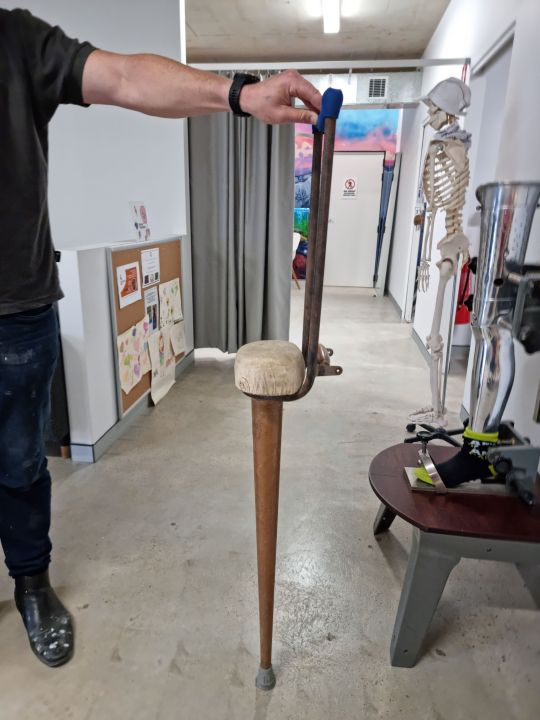
It's designed so that the user would rest their hip on the cushion and use the handle to hold it in place and move it in time with their walk. This kind of mobility aid isn't often used anymore (me nor my prosthetist have seen one out in the world), and seems to have faded in use during the 80's as sockets were invented that could better hold onto the hip and pelvis for through-hip amputees and the use of wheelchairs for amputees became less stigmatised.
There's also A new type of prosthetic has been developed called the Osseointegration prosthetic, which also doesn't use a socket either. These are very rare as they are incredibly expensive and still very risky, but these prosthetics bypass the socket and implant the prosthetic directly into the body through a rod planted inside one's stump bone. This rod has a clip at the end of the stump, so the external part of the prosthetic can be removed as needed (and replaced). The reason they are risky though is that they are EXTREMELY prone to infection. I only know one person who had this implanted successfully, but he has to be very careful to keep his leg clean or else it will get infected (and it frequently does, he's constantly on antibiotics). Everyone else I know who got it had to get it removed.
With time these implants will get safer, but we are a very, very long way off from that right now.
#Writing Disability with Cy Cyborg#disability#disabled#id in alt text#writing#writing disability#writeblr#authors of tumblr#writing advice#creative writing#on writing#writing tips#writing resources#writing help#authors on tumblr#authors#artists#artists on tumblr#artblr#drawing#art tips#art reference#amputee#amputee representation#prosthetics#disability aids#mobility aid#disability representation#disabled artist
2K notes
·
View notes
Text
How your disabled character's allies react to their disability can make or break the representation in your story: Writing Disability Quick Tips
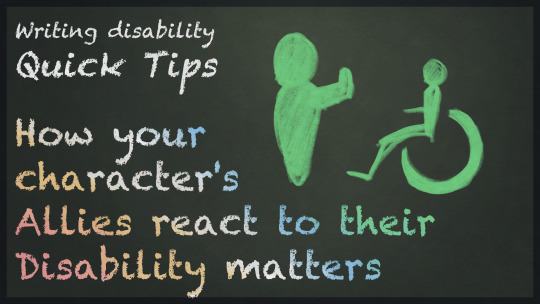
[ID: An image with “Writing Disability quick tips: How your character's allies react to their disability matters” written in chalk the colour of the disability pride flag, from left to right, red, yellow, white, blue and green. Beside the text are 2 poorly drawn people icons in green, one is standing with their hand up to the face of the other, who is in a wheelchair. /End ID]
Something I brought up in my big post about Toph Beifong was how the other characters reacted to Toph pointing out that things were not accessible to her and setting boundaries regarding her disability, which were ignored. I had more to say about it than I thought I did, as it turns out (when isn't that the case lol) but I feel like this is an important aspect of disability representation that is all too often over looked.
You can write the best, most accurate portrayal of a specific disability ever put to screen or page, but it won't mean much if all the other characters, specifically those we're supposed to like and empathise with, treat your character terribly for being disabled and having needs relating to said disability, especially if the story justifies their behaviour.
You see this most often with autistic characters and especially autistic-coded characters. The character in question will be given a bunch of autistic traits, most often traits relating to not understanding certain social dynamics or sarcasm, and when they get it wrong, the other characters we are supposed to like jump down their throat, tease them or outright abandon them. Autism isn't the only disability that gets treated this way, but it is one of the more common ones that get this treatment. It doesn't matter if you do everything else right when creating an autistic character if the other "good guys" constantly call them annoying, get angry at them or laugh at them for the very traits that make them autistic, or for advocating for their needs.
Likewise, if you have a leg amputee character who is otherwise done well, but is constantly being criticised by their allies for needing to rest their legs or taking too long to get their prosthetics on, it undermines a lot of the other work you've done. Same goes for having a wheelchair user who is accused of being a bore or a stick in the mud because they point out the places their friends want to go to on a group holiday have no wheelchair access, or a deaf character who is accused of being entitled for wanting their family to learn to sign, or anything else.
This isn't to say you can never have moments like these in your stories, but its important to remember that a) people with the same disability as your character will be in your audience. If you spend a whole season of your TV show shaming your autistic character for real traits that real autistic people have, they're not exactly going to feel welcome and may not want to hang around. b) it's going to very, very heavily impact people's perceptions of your "heros" who do this, especially in they eyes of your audience members who share the character's disability or who have had similar experiences. This isn't like calling someone a mean name or being a bit of a dick when you're sleepy, it's going to take a lot to regain audience appeal for the offending character, and depending on exactly what they do and how frequently they do it, they may not even be able to come back from it at all. And finally, c) there should be a point to it outside of just shaming this character and saying the other guy is an asshole. Like I said before, you're character is criticising real people's real disabilities and the traits or problems that come with them, things that they often have no control over, it shouldn't be used as a cheap, quick way to establish a quirky enemies to lovers dynamic or show that one guy is kind of an ass before his redemption arc. If you really must have your characters do this, be mindful of when and how you use it.
#Writing disability with Cy Cyborg#Quick tips#Disability#Disabled#Disability Representation#Writing Disability#Writing#Writeblr#Authors#Creators#Writing Advice#Disabled Characters#On Writing
747 notes
·
View notes